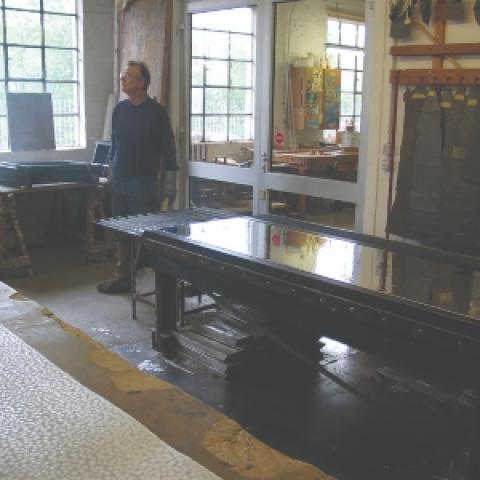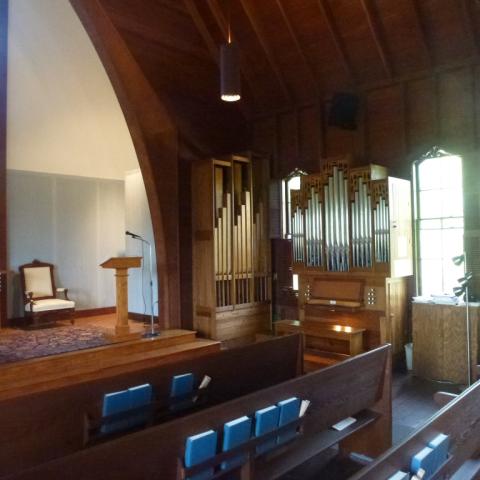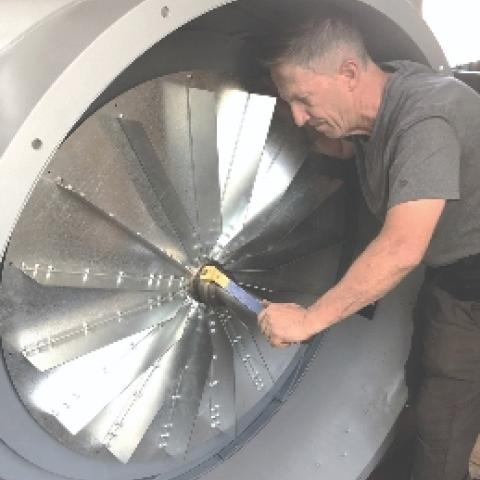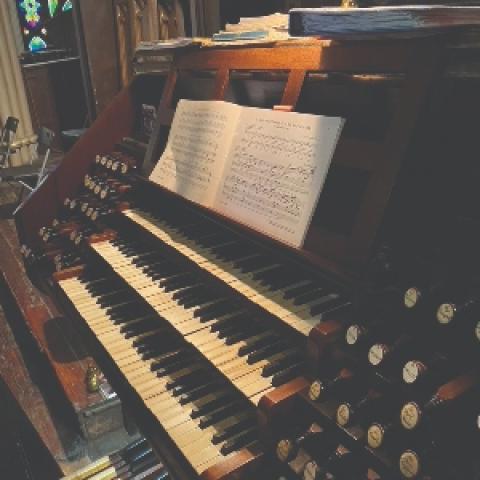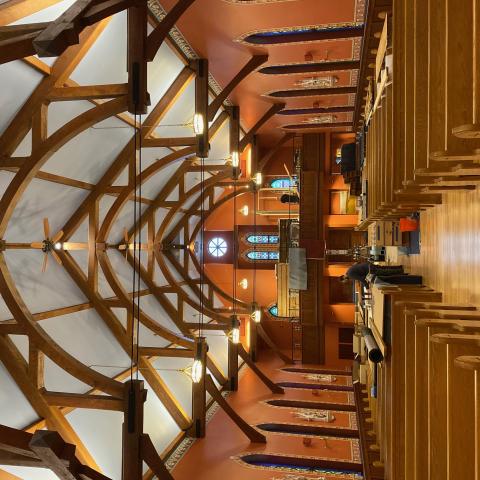
Changing seasons
I am writing in early October as the weather in New England is getting nippy. This is the first fall in our new home in Stockbridge, Massachusetts, where hillsides and mountain vistas are ablaze with natural color. We have completed the annual ritual of taking our boat Kingfisher out of the water after our tenth season with her. She is a “catboat”—no, not a multi-hulled catamaran. Catboats were developed as commercial fishing boats in the nineteenth century. They have a single sail with the mast mounted right in the bow so there is lots of sail area for power, and they are easy to handle alone. She is on stands “on the hard” at our boatyard in Round Pond, Maine, and last Saturday Wendy and I climbed aboard to fill tubs with dishes, utensils, pots and pans, bedding, and all the miscellaneous gear that seemed essential when still on the shelves at Hamilton Marine. We had taken most of the food off following our last sail, but there were still a couple bottles of booze in the locker. Nothing tastes better than the first gin and tonic at anchor by a remote island after a long day on the water. Fever Tree and limes are standards on our cruising shopping list.
For years, it has been part of my fall ritual to take our 450-square-foot sail to Pope Sails and Rigging in Rockland, Maine, for its annual cleaning, light repairs, and safe winter storage, but when I called Doug Pope last week to let him know I would be coming, he told me he was retiring and recommended Jenny Baxter who is buying Gambell & Hunter, a sailmaker in Camden, Maine. Jenny has been apprenticing with Grant Gambell for six years and is taking over his shop as he retires. She is about to move into a large commercial space and has purchased Doug Pope’s sail-cleaning equipment.
I drove to Gambell & Hunter’s old shop, which is housed in a barn in a residential neighborhood. Jenny was on the phone with her realtor when I arrived, and Grant came down in his stocking feet to help unload our sail into the shed. When Jenny got off the phone, she came down in bare feet to look over the sail and invited me upstairs to the sail loft, a large room with a spotless open floor, a couple stations with sewing machines, and racks of thread festooning the walls. Organ builders, if you ever need a custom-made rubber cloth windsock made to specifications, you will never do better than with a sailmaker. They know heavy fabric like you know poplar.
Camden is a legendary yachting center and is home to five or six large charter schooners. You can book a cabin for a week or two and sail the Maine coast with crews who prepare clambakes and boil lobsters onboard. Wendy and I have encountered the schooners several times during our cruises. We have seen guests diving off the boats at anchor and paddling kayaks into remote coves, and we have passed the schooners under weigh, their huge sails drawing the beautiful vessels at exhilarating speed. Jenny and Grant are a generation apart and grew up in different regions, but they both came to Camden, Maine, as young people to work on the schooners, serving on crews, running boats, and playing host to guests. They both developed their love of sailmaking while serving on those crews.
As an organbuilder and avid sailor, I have long understood that the two pursuits involve an attempt to control wind. I shared this thought with Grant and Jenny and learned that Jenny played the organ in high school. She assumed the organist position with arms and legs extended on the stool she was sitting on and mentioned how much she loves the Kotzschmar Organ in Portland, Maine. (I have served on the board of Friends of the Kotzschmar Organ for over twenty years.) Here’s wishing Jenny Baxter the best in her new venture, and I am looking forward to seeing her in the spring when it is time to put Kingfisher back in the water.
Stars in your eyes
When I was ten years old singing in the choir in my home church, the organist was a harpsichord maker, and I was captivated by the idea that he was playing on an instrument he had built. Today, I know dozens of people who are passionate about building pipe organs the way Jenny is passionate about sailmaking. I remember feeling special when I was assigned my first task for a teenage summer job in an organ shop, standing in the parking lot with a can of Zip-Strip and some gold-painted façade pipes on sawhorses. I admit that I am less enchanted by that same task today. I remember the adventure of going on the road to install an organ for the first time. I remember the thrill of hearing an organ come to life, turning on the wind for the first time, sounding the first notes, and seeing the glowing faces of the people in the church when they heard the first hymn played on their new organ.
Of course, I also remember difficult and demanding days, furiously heavy days, and disappointments when things would not work or did not turn out well, and I remember that special feeling when I made mistakes. Along with millions of Americans, I grew up watching ABC’s Wide World of Sports on Sunday afternoons, hearing the slogan, “the thrill of victory, and the agony of defeat,” watching a ski jumper’s spectacular wipeout repeated week after week. My mentor John Leek in Oberlin immortalized my apprentice mistakes by nailing them to the wall above my workbench. They were still there when I visited ten years after I left his shop.
That Zip-Strip summer was 1975, and I was employed by Bozeman-Gibson & Company after my freshman year at Oberlin. I was working on the façade for a rebuilt nineteenth-century organ we were installing in a Salvation Army Chapel in Providence, Rhode Island. The chapel was in a newish building that included offices and had some guest rooms where we were staying. Breakfast and lunch were served in the kitchen by an ex-con named Vinnie, pleasant enough, but for dinner we drove across town to the Salvation Army’s men’s service center where we stood in a cafeteria line with what seemed like hundreds of homeless men. It was a good learning experience for a young man from comparative privilege.
During the two summers I worked for Bozeman-Gibson, I helped with organ projects in Providence; Castleton, Vermont; Belfast, Maine; and Squirrel Island off Boothbay Harbor, Maine, which is seven miles from our house in Newcastle, Maine, as the crow flies in water that we have sailed for years. Last summer Wendy and I spent a night onboard Kingfisher at a mooring in Linekin Bay near Boothbay Harbor and sailed around Squirrel, with Wendy listening yet again to my reminiscing about that project forty-six years ago.
John Farmer, who has run his organ company in Winston-Salem, North Carolina, for forty years, and I were working together on the Squirrel Island organ. It was completed in the workshop in time for us to install it in the crossing of the Cathedral of the Holy Cross in Boston, Massachusetts, for a concert of the Handel & Haydn Society during the 1976 American Guild of Organists national convention with Barbara Bruns playing a Handel organ concerto. The one-manual, eleven-rank organ was a perfect fit for that music. The convention ended with AGO Night at the Pops with Arthur Fielder, E. Power Biggs, and the Boston Pops Orchestra playing Rheinberger in what I believe was Biggs’s last public performance. (He died in March 1977.) Boston’s Symphony Hall was filled with two-thousand organists. At the end of the concert, Fiedler faced the audience and said something like, “We thought that you would know some of the words.” The orchestra gave those introductory measures, and the audience swept to its feet and bellowed “Hallelujah” like it’s never been sung before or since.
John and I packed up the organ and drove it to Boothbay Harbor where we loaded it onto the private ferry for Squirrel Island—it took three trips. We carted it up the dirt road to the non-denominational chapel in a rusty old pickup truck, the only motor vehicle on the island. We slept in the house of the superintendent of the island, who was also a lobsterman, so there was lobster meat in the scrambled eggs in the morning, and we were given the use of a motorboat so we could go to the mainland for restaurant dinners. We ate at the Tugboat Inn in Boothbay Harbor and Fisherman’s Wharf in East Boothbay, both of which are still there. Fisherman’s Wharf in 1976 is where I first heard Drop Kick Me Jesus Through the Goalposts of Life by Bobby Bare (Bill Clinton’s favorite country song according to Mr. Bare himself, as seen on a YouTube video) and I Just Kicked the Daylights Out of My CB Radio, composer unknown, sung by a raucous country band. That would have been less than two weeks after that triumphant concert at Symphony Hall in Boston. Who says I’m not well-rounded?
What an adventure it was for a twenty-year-old with stars in his eyes. I was asked to visit the organ ten years ago to update the assessed value of the organ for their insurance policy and rode out to the island on the same ferry, refreshing my memories of that wonderful adventure as a fledgling organbuilder.
The wind
In 1995, I restored an organ built by E. & G. G. Hook & Hastings (Opus 466, 1868) and relocated it to the Follen Community Church (UUA) in Lexington, Massachusetts. The project included the restoration of the feeder bellows so the organ could be pumped by hand. Yuko Hayashi brought her organ class from New England Conservatory to Follen several times to experience the difference between the sound of the organ when pumped by hand or fed with an electric blower.
When that project was finished, one of the first recitals was played by Peter Sykes, and unbelievably, there was a power failure midway through. Organ historian Barbara Owen volunteered to pump. As she walked up the steps to the platform, she faced the audience and recited verses from Oliver Wendell Holmes’s poem, The Organ Blower, excerpted here:
No priest that prays in gilded stole,
To save a rich man’s mortgaged soul;
No sister, fresh from holy vows,
So humbly stoops, so meekly bows;
His large obeisance puts to shame
The proudest genuflecting dame,
Whose Easter bonnet low descends
With all the grace devotion lends.
O brother with the supple spine,
How much we owe those bows of thine!
Without thine arm to lend the breeze,
How vain the finger on the keys!
Though all unmatched the player’s skill,
Those thousand throats were dumb and still:
Another’s art may shape the tone,
The breath that fills it is thine own. . . .
This many-diapasoned maze,
Through which the breath of being strays,
Whose music makes our earth divine,
Has work for mortal hands like mine.
My duty lies before me. Lo,
The lever there! Take hold and blow!
And He whose hand is on the keys
Will play the tune as He shall please.
Never was a memorized verse inserted so deftly. Judging from the graffiti we find around the pump handles of historic organs the reality is that pumping the organ was less lofty than what Mr. Holmes observed or imagined.
I have heard stories about how organists resisted the development of electric playing actions at first, claiming that being separated from their instruments by wires would make playing impersonal. They got over that quickly as the Skinner Organ Company, to name one, built its 301st organ in 1920. I have never heard any hint that organists resisted the introduction of electric organ blowers.
Marcel Dupre’s Recollections, published in translation by Ralph Kneeream, relates a story Dupré told of a Sunday morning at the Cathedral of Notre-Dame in Paris. His visitor in the organ loft was Claude Johnson, one the directors of Rolls-Royce. (Johnson had commissioned Dupré’s Fifteen Pieces, Vêpres du commun des fêtes de la Sainte Vierge, opus 18, which are dedicated to him.) Dupré was improvising on full organ after the Mass when the organ wind stopped. When Johnson asked what the trouble was, Dupré replied that the five men who were pumping the organ stopped when they got tired. Johnson went behind the organ, gave them some money, and Dupré started playing again, but not for long. When the wind died again, Johnson announced that he would give an electric organ blower to Notre-Dame and asked Dupré to have Cavaillé-Coll develop a plan, adding, “Since I am an Anglican, it would probably be wise to have the Cardinal’s approval.”1 Dupré wrote that this happened in 1919. I can only assume that he was correct, but that seems pretty late in history for such an important church to get its first electric blower.
Newfangled
In the nineteenth century, officers in the British Navy opposed the introduction of steam-powered vessels, complaining that the long tradition of sailors would be reduced to a mob of mechanics. They were overlooking the fact that a steam-powered vessel would be deadly to a sailing ship as it could operate against wind and tide or without wind at all. While commercial shipping converted quickly to internal combustion propulsion, sailboats have been popular as pleasure craft without interruption. Kingfisher has a twenty-horsepower diesel engine mounted in a spacious compartment under the deck of the cockpit that allows us to “sail” to and from docks and moorings, mostly without incident.
We bought Kingfisher from the boatyard near New Bedford, Massachusetts, where she was built. That first summer, we sailed her 250 miles home to Maine. We did not sail at night, so the trip took six days and five nights. Later, I wrote an essay about our maiden voyage for Catboat Journal, a quarterly magazine published by the Catboat Association. A guy in California, who would be teaching a class for sailing catboats the next summer at the Wooden Boat School in Brooklin, Maine (about seventy-five miles from home by water), emailed me suggesting that if we happened to be nearby at that time, he would love to have us address the class. The Wooden Boat School is a mecca for sailors, and we made sure we would just happen to be there, planning our summer’s cruise around this very event. It was a thrill to have our fiberglass boat on a guest mooring there.
Joining us as a casual commentator for the class was Bill Cheney, widely known in our area for his virtuoso sailing of a catboat, the same model and make as ours with one substantial difference—his boat has no engine. At dinner after the class with the students and their instructor, Bill and I were regaling the table with stories when I admitted that I am not the sailor he is because I am happy to have the engine for close maneuvering and for getting places when there is no wind. His response, “Where do you keep your wine?”
Notes
1. Marcel Dupré, Recollections, trans. and ed. Ralph Kneeream, Belwin-Mills, 1972, 69.

